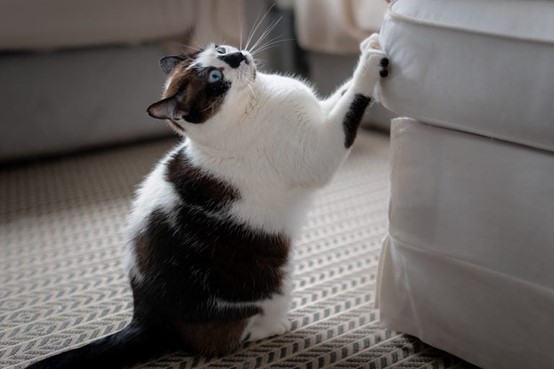Here's How to Keep a Cat from Scratching the Furniture

Here's How to Keep a Cat from Scratching the Furniture
Keeping a cat from scratching furniture can be challenging, but with consistent training and providing alternative outlets for their scratching instincts, you can save your furniture and keep your cat happy. Here's a guide to help you achieve that:
Provide scratching posts and pads: Cats scratch to mark territory and maintain their claws, so it's essential to offer suitable alternatives. Invest in multiple scratching posts and pads made from different materials like sisal, cardboard, or carpet. Place them near your furniture or in areas where your cat spends a lot of time.
Choose the right scratching post: Cats have individual preferences when it comes to scratching surfaces. Some like vertical posts, while others prefer horizontal ones. Observe your cat's behavior to determine their preference, and try to provide the type of scratching post they prefer.
Use catnip or attractants: Encourage your cat to use the scratching post by sprinkling catnip on it or using catnip spray. The scent will attract them to the post, making them more likely to use it.
Positive reinforcement: When you catch your cat using the scratching post or pad, reward them with praise, treats, or affection. Positive reinforcement will encourage them to continue using the designated scratching area.
Redirect bad behavior: If you catch your cat scratching the furniture, gently redirect them to the appropriate scratching post. Avoid punishing or yelling at your cat, as it can create fear or anxiety and make the situation worse.
Furniture deterrents: To discourage your cat from scratching furniture directly, use deterrents like double-sided sticky tape, aluminum foil, or specially designed furniture guards. Cats dislike the sticky or crinkly texture, which may deter them from scratching.
Trim your cat's claws: Regularly trimming your cat's claws can reduce the damage caused by scratching. Be sure to use cat-specific claw clippers and take care not to cut into the quick (the pink part inside the claw).
Protect high-value furniture: If there are particular pieces of furniture that your cat is especially drawn to, consider using temporary covers or blankets to protect them until your cat learns to use the scratching posts consistently.
Use deterrent sprays: There are commercially available cat deterrent sprays that emit odors cats dislike. Apply these sprays to the furniture you want to protect.
Time and patience: Training a cat takes time and patience. Be consistent with your approach and give your cat the opportunity to learn and adjust to the new behavior you're encouraging.
Remember, scratching is a natural behavior for cats, so it's essential to provide them with suitable alternatives rather than trying to suppress their instincts entirely. By following these steps, you can redirect your cat's scratching behavior and protect your furniture effectively.
